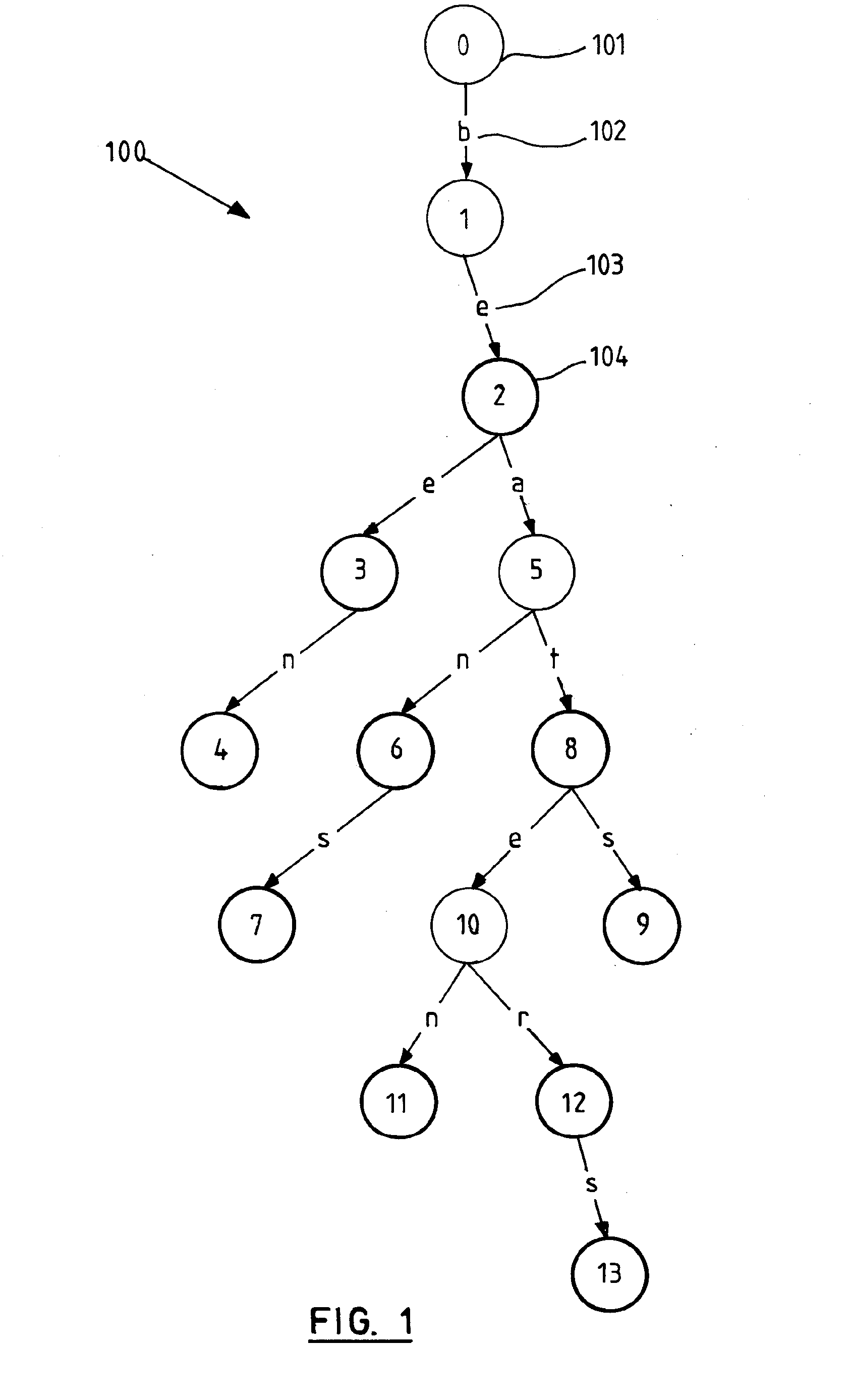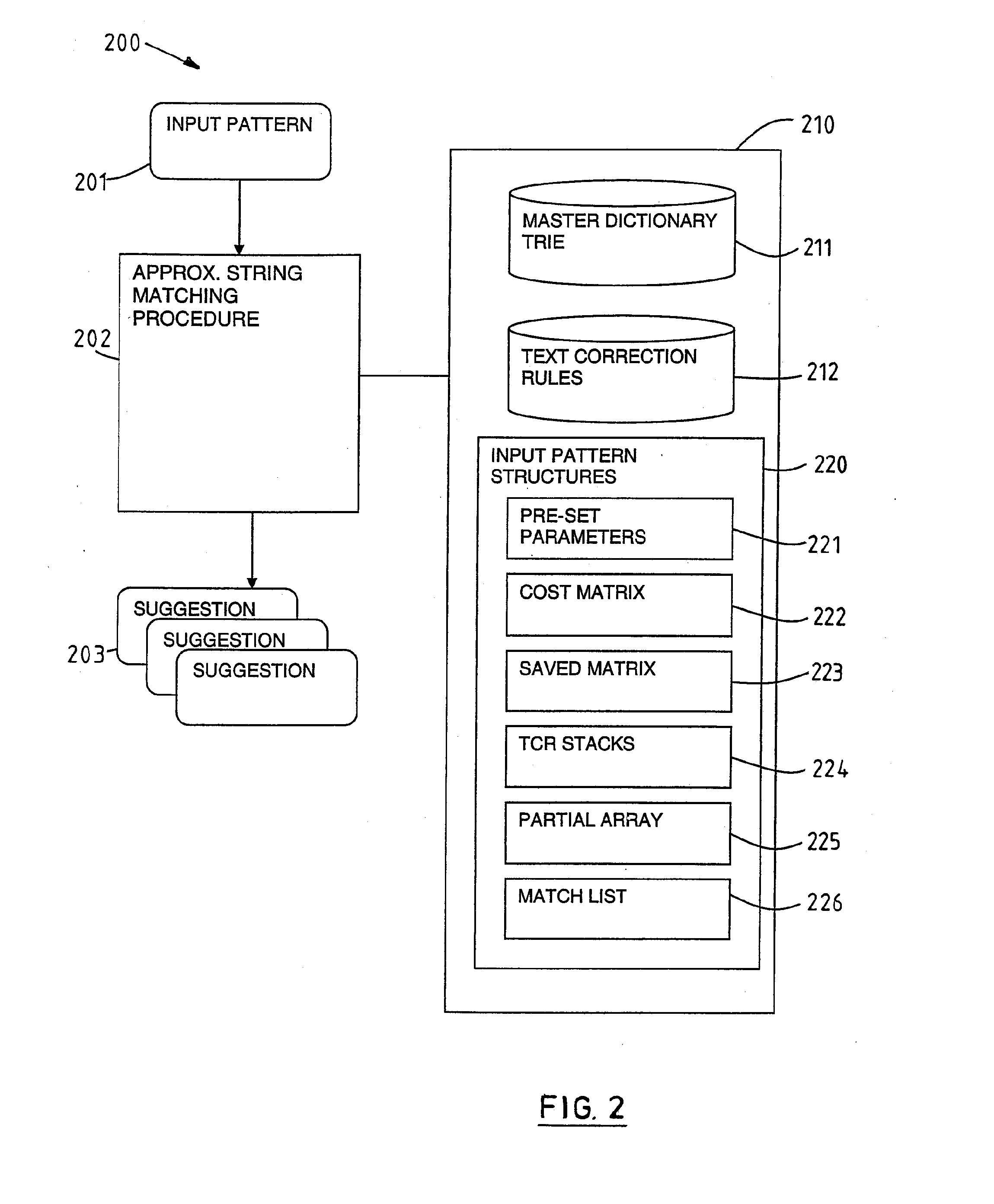Method and system for approximate string matching
a string matching and approximation technology, applied in the field of approximation string matching, can solve problems such as unoptimized efficiency, and achieve the effect of significant performance boos
- Summary
- Abstract
- Description
- Claims
- Application Information
AI Technical Summary
Benefits of technology
Problems solved by technology
Method used
Image
Examples
worked example 1
[0158]Referring to FIG. 10A, a worked example is provided to illustrate the described method further. The worked example follows the steps through the trie structure 1000 shown in FIG. 10A. This example shows the working of the TCR stack mechanism. Decompounding of words is not shown in this example.
Input pattern “adn”
Input parameters:
[0159]cost_del=35
[0160]cost_ins=30
[0161]cost_sub=45
[0162]cost_tra=25
[0163]step_cost=1000
[0164]max_ins=max_del=1
[0165]TC rules:
1: a−>u (10)2: d−>s (20)3: d−>dd (10)4: dn−>n (10)Additionally (transposition rules):5: ad−>da (25)6: dn−>nd (25)
[0166]After matching rules with the input pattern, TCR data looks as follows. Only the relevant fields are shown. For example, the cost field is initially left undefined and therefore not shown, and the saved cost minima field applies to decompounding which is not shown in this example. Each TCR element is indexed by [pos, j, count]:
[1, 0,0]: char d init 2025 disp 0[1, 0,1]: char u init 1010 disp 0[1, 0,2]: char d ini...
example 1a
max_cost=50
[0167]After processing at each step, only the cost field of the TCR elements is shown as this is the only field that changes.
[0168]Step 0. Before starting, the costs are initialized as, cost for position 0, displacement −1, 0, or 1:
[0169]Cost[0]: −1:∞0:0 1:35
[0170]Step 1. Processing the first character ‘a’ to go to State 1.
Pos 1, gathered string: aCost[1]: −1:30 0:0 1:35TCR rules:[1,0]: [0:∞] [1:∞] [2:∞][1,1]: [0:∞] [1:∞]
−1:30 is the result of insertion, the actual value is computed as Cost[0, 0]+cost_ins.
0:0 is the result of a match of the character ‘a’ in the pattern with ‘a’ in the trie transition, computed as Cost[0, 0]+0.
1:35 is the result of deletion, computed as Cost[1, 0]+cost_del.
None of the TCR stack elements in this position match the character ‘a’, thus all TCR element costs are set to ∞.
[0171]Step 2. Processing second character ‘n’ to go to State 2.
Pos 2, gathered string: anCost[2]: −1:30 0:45 *1:10TCR rules:[2,−1]: [0:∞] [1:∞] [2:∞][2,0]: [0:∞] [1:1025] [2:∞...
example 1b
max_cost=30
[0195]In Example 1B, since max_cost is not bigger than the smaller of cost_sub and cost_ins, even accumulated cost 0 is not below the restriction threshold, which means that only steps in the trie that have potential will be investigated.
[0196]After Step 1, the characters are gathered that match the characters in the pattern at positions pos+j where Cost[pos,j] is smaller than max_cost. Here, this is only ‘d’. The TCR elements for pos=2 are examined for ones that could yield a low enough cost. In this case they are:
[2,−1,2]: char d init 2010 disp 0[2,0,1]: char n init 2025 disp 0[2,0,2]: char s init 1020 disp 0[2,1,1]: char n init 1010 disp 0
The rest are rejected because their Cost[1,disp] or prev.cost modulo step_cost are not smaller than our max_cost.
[0197]The final list of possible continuations cn is [‘d’, ‘n’, ‘s’].
[0198]After Step 2, a suggestion is output of ‘an(10)’ and again possible continuations are looked for. Only Cost[2,1] is less than max_cost, but the patt...
PUM
 Login to View More
Login to View More Abstract
Description
Claims
Application Information
 Login to View More
Login to View More - R&D
- Intellectual Property
- Life Sciences
- Materials
- Tech Scout
- Unparalleled Data Quality
- Higher Quality Content
- 60% Fewer Hallucinations
Browse by: Latest US Patents, China's latest patents, Technical Efficacy Thesaurus, Application Domain, Technology Topic, Popular Technical Reports.
© 2025 PatSnap. All rights reserved.Legal|Privacy policy|Modern Slavery Act Transparency Statement|Sitemap|About US| Contact US: help@patsnap.com



